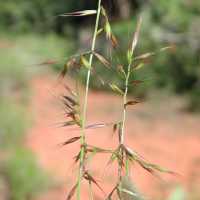Annuals, Terrestrial, not aquatic, Stems nodes swollen or brittle, Stems erect or ascending, Stems geniculate, decumbent, or lax, sometimes rooting at nodes, Stems caespitose, tufted, or clustered, Stems terete, round in cross section, or polygonal, Stem internodes hollow, Stems with inflorescence less than 1 m tall, Stems, culms, or scapes exceeding basal leaves, Leaves mostly cauline, Leaves conspicuously 2-ranked, distichous, Leaves she athing at base, Leaf sheath mostly open, or loose, Leaf sheath smooth, glabrous, Leaf sheath hairy, hispid or prickly, Leaf sheath and blade differentiated, Leaf blades linear, Leaf blades very narrow or filiform, less than 2 mm wide, Leaf blades mostly flat, Leaf blade margins folded, involute, or conduplicate, Leaf blades mostly glabrous, Ligule present, Ligule an unfringed eciliate membrane, Inflorescence terminal, Inflorescence an open panicle, openly paniculate, branches spreading, Inflorescence solitary, with 1 spike, fascicle, glomerule, head, or cluster per stem or culm, Inflorescence lax, widely spreading, branches drooping, pendulous, Inflorescence with 2-10 branches, Flowers bisexual, Spikelets laterally compressed, Spikelet less than 3 mm wide, Spikelets with 3-7 florets, Spikelets solitary at rachis nodes, Spikelets all alike and fertille, Spikelets bisexual, Spikelets disarticulating above the glumes, glumes persistent, Spikelets disarticulating beneath or betw een the florets, Spikelets secund, in rows on one side of rachis, Rachilla or pedicel glabrous, Glumes present, empty bracts, Glumes 2 clearly present, Glumes distinctly unequal, Glumes shorter than adjacent lemma, Glumes equal to or longer than adjacent lemma, Glumes 1 nerved, Glumes 3 nerved, Lemma coriaceous, firmer or thicker in texture than the glumes, Lemma 5-7 nerved, Lemma body or surface hairy, Lemma apex acute or acuminate, Lemma distinctly awned, more than 2-3 mm, Lemma with 1 awn, Lemma awn less than 1 cm long, Lemma awn 1-2 cm long, Lemma awned from tip, Lemma awns straight or curved to base, Lemma margins thin, lying flat, Lemma straight, Palea present, well developed, Palea membranous, hyaline, Palea about equal to lemma, Palea 2 nerved or 2 keeled, Stamens 1, Styles 2-fid, deeply 2-branched, Stigmas 2, Fruit - caryopsis, Caryopsis ellipsoid, longitudinally grooved, hilum long-linear.
Common Name: small fescue
Duration: Annual
Nativity: Native
Lifeform: Graminoid
General: Annual with solitary or loosely tufted, usually glabrous but occasionally puberulent stems 15-75 cm.
Vegetative: Sheaths glabrous or pubescent, ligules 0.5-1 mm, blades usually shorter than 10 cm, 0.5-1 mm wide, usually rolled, occasionally flat, glabrous or pubescent.
Inflorescence: Panicles, but sometimes spikelike racemes, 2-24 cm long, 0.8-8 cm wide; branches solitary, with axillary pulvini, appressed to erect when immature, spreading to reflexed at maturity; spikelets 4-10 mm with 1-6 florets, often purple tinged, rachilla internodes 0.6-1.2 mm; glumes smooth, scabrous or pubescent, lower 1.7-5.5 mm, one half to three quarters the length of upper glumes, upper 3.5-7.5 mm; lemmas 3.5-9.5 mm, smooth, scabrous or evenly pubescent, 5-veined, awns of the lowermost lemma in each spikelet 6-20 mm.
Ecology: Found on dry slopes and rocky hillsides, often in disturbed areas below 5,000 ft (1524 m); flowers April-June.
Notes: There are three varieties in the region: var. ciliata, var. microstachys, and var. pauciflora. They are distinguished by the glumes and lemmas being smooth or scabrous in var. pauciflora, the glumes and lemmas being pubescent in var. ciliata, and the glumes being glabrous and the lemmas being pubescent in var. microstachys.
Ethnobotany: Unknown
Etymology: Festuca is Latin for grass stalk or straw, while microstachys is from the Greek words for small and ear of corn or spike.
Synonyms: None
Editor: SBuckley, 2010




